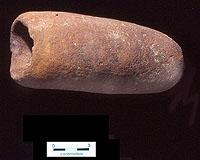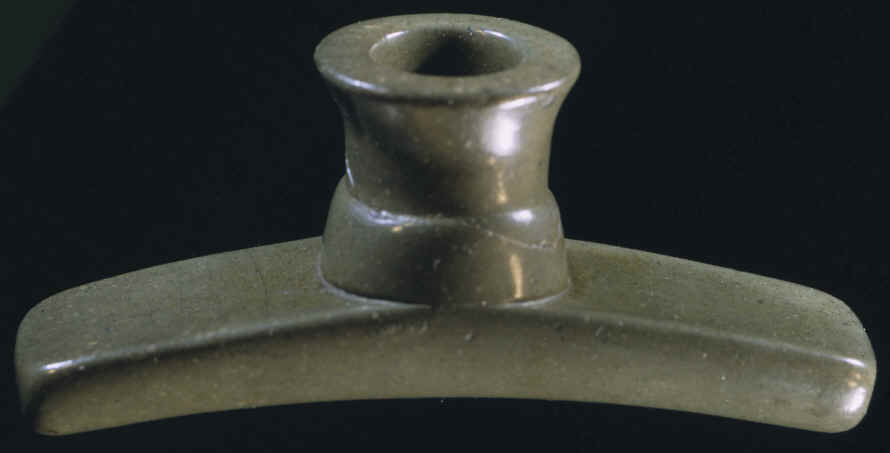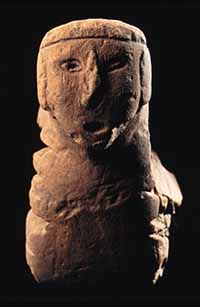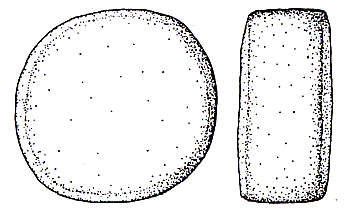

INTRODUCTION
First, recall the goals of the archaeological excavations at hypothetical Hilltopper Shelter. One research question concerns when the site was occupied. Is Hilltopper Shelter a single component historic period site or a multicomponent site that also represents prehistoric occupations? Can a specific range of years be specified for each occupation? The other research question relates to the function of the site during each temporally-distinct occupation. How was the site used during each occupation?
In the first lab we considered how lithic
artifacts
might be used to answer these questions. In this lab, we examine
how fired clay artifacts can be used to address these
questions.
Analysis of the ceramics, pottery, pipes, marbles, bricks, and other
fired clay objects from the shelter will
proceed
with these questions in mind. How can fired clay
artifacts
be used to determine period of occupation? How can fired clay
artifacts be used to determine site function? Some approaches are
explained and demonstrated in this lab.
OCCUPATION HISTORY
PREHISTORIC
DIAGNOSTICS
Several types of fired clay objects can be
used to date prehistoric site occupations. Most commonly,
chronologically diagnostic ceramics and
pottery
may be used to determine period of site occupation. Ceramics and
pottery vary stylistically over time, and different stylistic types are
indicative of certain time periods. Stylistic attributes of ceramics
and
pottery include temper composition, surface treatment, decoration,
vessel
wall thickness, and shape. Other chronologically diagnostic fired clay
items are smoking pipes and gaming pieces.
In Kentucky, prehistoric pottery was
manufactured
in a number of styles. Table 1 summarizes typical vessel forms,
tempering,
surface treatment, and decoration for pottery vessels from prehistoric
time periods. More detailed descriptions of Woodland and Mississippi
period pottery types for western Kentucky are available by clicking on
the links to Table 2 and Table 3, respectively (Microsoft
Word documents).
| PERIOD | VESSEL FORMS | SURFACE TREATMENT |
TEMPER | STYLISTIC TYPES |
| Early Woodland (1000 - 200 BC) |
conoidal jars with narrow flat bases | plain, fabric impressed, and cordmarked surface treatments | tempered with sand, crushed limestone, or other coarsely ground rock | Fayette Thick, Crab Orchard (Baumer) |
| Middle Woodland (200 BC - AD 500) |
conoidal and barrel-shaped jars, jars with thick outflaring rims, tetrapodal vessels | plain, cordmarked, cord-wrapped dowel, fabric impressed, brushed, scratched, and stamped surface treatments; noded or zoned areas with incising, punctating, dentate stamping, and rocker stamping less common | characteristically limestone tempered, although a variety of tempering materials was used | Noded Crab Orchard, Havana Zoned Dentate, Mann |
| Late Woodland (AD 500 - 900) |
subconical or subglobular jars with angular shoulders | stamped, cordmarked, and checked surface treatments |
tempers include limestone, grit, and sandstone | Newtown, Sim's Creek |
| Mississippi (AD 900 - 1550) |
jars, bowls, bottles, pans or salt pans, funnels, plates | plain, fabric impressed, cordmarked, incised, stamped, and red filmed surface treatments | tempers include clay grog and shell | Baytown Plain, Mulberry Creek, Cordmarked, Wickliffe Thick, Wolf Creek Check Stamped, McKee Island Cordmarked, Mississippi Plain, Bell Plain, Old Town Red, Kimmswick Fabric Impressed, Crosno Cordmarked |
Other chronologically diagnostic clay
objects
manufactured by prehistoric inhabitants of Kentucky include smoking
pipes and discoids, though both more frequently were made of
stone. Tubular and elbow clay smoking pipes
were made during the Late Archaic period (3000 - 1000 BC) and Early
Woodland
period. Platform pipes are diagnostic of the Middle Woodland
period;
many platform pipes are decorated with animal effigies. Tubular,
elbow and human effigy pipes were made during the Mississippi
period. Discoids are characteristic of the Mississippi period.




Figure 1. Examples of Tubular (left), Platform (middle), and Effigy
(right) Pipes. Drawings of Top and Side Views of Discoidals.
ASSIGNMENT:
Examine
the comparative prehistoric pottery collection in the lab. Use
the
comparative materials to identify chronologically diagnostic pottery
recovered
from Zone II of Hilltopper Shelter. Record the specimen number,
provenience,
and likely time period for each pottery artifact. Repeat for
other diagnostic clay objects. Record any
other
attributes you deem relevant to answering the research questions.
HISTORIC
DIAGNOSTICS
Historic ceramic types varied over time in
terms of paste type, manufacturing technique, and decoration.
Table 4 summarizes ceramic stylistic variation for the historic period
in the
southeastern United States.
| TYPE | TIME RANGES |
| Pearlware, undecorated | AD 1779 - 1820 (Hume 1974) AD 1779 - 1830 (Miller 1999, personal communication) Pre AD-1890s (Price 1979) |
| Basalt ware (Egyptian black ware) | AD 1790 - 1846 (Miller 1999, personal communication) |
| Whiteware, purple transfer printed | AD 1810 - 1828 (Hughes 1968) Post AD late 1820s (Price (1979) |
| Light-colored earthenware, blue painted or red painted |
Post AD 1820s (Miller 1999, personal communication) |
| Whiteware, general | Post AD 1820s (Price 1979) |
| Ironstone, green overglaze stippled transfer printed | Post AD 1807 (Miller 1999, personal communication) Post AD 1848 (Cotter 1968) |
| Ironstone, general | Post AD 1865 (Price 1979) |
| Stoneware, interior glazing | Post AD 1900 (Munsey 1970) |
| Salt glazed, scratch brown or scratch blue | AD 1740 - 1760 (Miller 1999, personal communication) |
| Stoneware, red | AD 1770s (Miller 1999, personal communication) |
| Earthenware, mocha decorated | AD 1795 - 1830s (Miller 1999, personal communication) |
| Yellowware, mocha decorated | AD 1840s - 1904 (Miller 1999, personal communication) |
| Earthenware/stoneware, shell edge, rococo | AD 1784 - 1812 (Miller 1999, personal communication) |
| Earthenware/stoneware, shell edge, even scallop | AD 1809 - 1831 (Miller 1999, personal communication) |
| Earthenware/stoneware, shell edge, even scallop with bud |
AD 1813 - 1834 (Miller 1999, personal communication) |
| Earthenware/stoneware, shell edge, plain border, embossed patterns (wheat and grape, festoon garlands, rope and boughs) |
AD 1820s - 1835 (Miller 1999, personal communication) |
| Earthenware/stoneware, shell edge, plain border with impressed design |
AD 1841 - 1857 (Miller 1999, personal communication) |
| Earthenware/stoneware, shell edge, painted | AD 1874 - 1884 (Miller 1999, personal communication) |
| Earthenware/stoneware, edge lined | AD 1790s - 1830s (Miller 1999, personal communication) |
| Gaudy Dutch | AD 1810 - 1820 (Miller 1999, personal communication) |
| Earthenware/stoneware, painted, chrome colors (red) | Post AD 1820s (Miller 1999, personal communication) |
| Earthenware/stoneware, painted, non-chrome colors (green, brown, yellow) |
AD 1795 - 1830 (Miller 1999, personal communication) |
| Earthenware/stoneware, painted, chrome colors (red, green, brown) |
AD 1830s - 1865 (Miller 1999, personal communication) |
| Earthenware/stoneware, painted, Adams pattern, king's rows |
AD 1830s (Miller 1999, personal communication) |
| Earthenware/stoneware, painted, sprig pattern, brown or black |
AD 1835 - 1865 (Miller 1999, personal communication) |
| Earthenware/stoneware, transfer printed, general | Post AD 1753 (Miller 1999, personal communication) |
| Earthenware/stoneware, transfer printed, underglaze | Post AD 1784 (Miller 1999, personal communication) |
| Earthenware/stoneware, transfer printed, stippling | Post AD 1807 (Miller 1999, personal communication) |
| Pearlware, transfer printed, brown | AD 1790 - 1830 (Miller 1999, personal communication) |
| Flo blue | Post AD 1840s (Miller 1999, personal communication) |
| Ironstone (stone china) | Post AD 1813 (Miller 1999, personal communication) |
| White granite | Post AD 1845 (Miller 1999, personal communication) |
| Marked hotel wares, general | Post AD 1870s (Miller 1999, personal communication) |
| Marked hotel wares, transfer printed, underglaze, polychrome |
Post AD 1908 (Miller 1999, personal communication) |
Other chronologically diagnostic clay
objects
manufactured by historic inhabitants of Kentucky include smoking
pipes. For clay pipes manufactured in England, the diameter of the bore
in the pipe stem decreased in size over time, as summarized in Table 5
(Deetz 1996:28).
| DIAMETER (in) |
DIAMETER (mm) |
DATE RANGE |
| 9/64 |
3.57 |
AD 1590-1620 |
| 8/64 |
3.18 |
AD 1620-1650 |
| 7/64 |
2.78 |
AD 1650-1680 |
| 6/64 |
2.38 |
AD 1680-1720 |
| 5/64 |
1.98 |
AD 1720-1750 |
| 4/64 |
1.59 |
AD 1750-1800 |
ASSIGNMENT:
Examine
the comparative historic ceramic collection in the lab. Use the
comparative
materials to identify chronologically diagnostic ceramics recovered
from
Zone I of Hilltopper Shelter. Record the specimen number,
provenience,
and likely time period for each ceramic artifact. Record any
other
attributes you deem relevant to answering the research questions.
SITE FUNCTION
Fired clay assemblages can be used to identify possible site functions during each. Keeping in mind the site function interpretive models covered in the site report (Tables 1 and 2), use the fired clay assemblages from each stratigraphic zone to characterize site use and to identify activities that might have occurred at Hilltopper Shelter.
Pottery vessels (jars, bowls, bottles,
pans)
usually had utilitarian functions in prehistoric societies. Such
items were used in domestic contexts for storing food items, preparing
foods, cooking foods, transporting materials, and making salt. Cooking
vessels tend to be thinner than storage vessels. Pans used for
evaporating water to produce salt tend to be very wide but shallow.
Clay pipes were used for smoking plant materials in domestic and ceremonial contexts. Discoids were used for entertainment as they were part of a "stick and ball" game.
ASSIGNMENT: Using reference materials and comparative collections in the lab, identify the types of pottery functional types from each stratigraphic zone. Record the specimen number, provenience and functional type for each artifact. Record any other attributes you deem relevant to answering the research questions.
Ceramic vessels from historic contexts are
often functionally classified based on analogy with modern ceramic
functional
types. Typical functional classes and subclasses include table
wares
(plates, salad bowls, soup bowls, cups), serving wares (serving bowls,
turins, platters, tea pots), food preparation wares (mixing bowls, tea
pots), storage wares (crocks, decanters), and decorative wares (boxes,
vases).
Clay pipe bowls were used for smoking tobacco and
other plant material in domestic contexts. Clay marbles were used for
entertainment. Bricks are architectural remains used for the
construction of buildings.
ASSIGNMENT: Using
reference
materials and comparative collections in the lab, identify the types of
ceramic functional types from each stratigraphic zone. Record the
specimen number, provenience and functional type for each
artifact.
Record any other attributes you deem relevant to answering the research
questions.
SITE REPORT
The results of the pottery and ceramic analyses must be described in the site report. The pottery and ceramic analysis sections usually includes descriptive text, data tables, data figures, quantitative analysis, and line drawings or black-and-white photographs of diagnostic artifacts.
ASSIGNMENT: Compose the prehistoric pottery and historic ceramic analysis sections of the final site report. Follow the stylistic format of the existing portions of the site report. Click here for more details.
The lab report for pottery and ceramics is
due at the beginning of class time on Monday, October 16.
REFERENCES
Cotter, John L. (compiler)
1968 Handbook for Historical Archaeology. Publisher unknown,
Philadelphia.
Deetz, James
1996 In Small
Things Forgotten: An Archaeology of Early American Life. Anchor,
New York.
Hughes, George Bernard
1968 Victorian Pottery and Porcelain. Spring Books, London.
Hume, Ivor Noel
1974 Here Lies Virginia: An Archaeologist’s View of Colonial
Life and History. Alfred A. Knopf, New York.
Lewis, R. Barry
1996 Mississippian Farmers. In Kentucky Archaeology, edited
by R. Barry Lewis, pp. 127-160. The University Press of Kentucky,
Lexington.
Miller, George L.
1999 Personal communication, ceramic workshop. 2nd Annual Meeting of
the South Central Historical Archaeology Conference, Memphis, TN.
Munsey, Cecil
1970 The Illustrated Guide to Collecting Bottles. Hawthorn
Books,
New York.
Nance, J. D.
1974 Ancient Man in Land Between the Lakes. Tennessee Valley
Authority, city unknown.
Price, Cynthia R.
1979 19th Century Ceramics … [sic] in the Eastern Ozark Border
Region.
Center for Archaeological Research, Southwest Missouri State
University,
Springfield.
Railey, James A.
1996 Woodland Cultivators. In Kentucky Archaeology,
edited
by R. Barry Lewis, pp. 79-126. The University Press of Kentucky,
Lexington.
Return to Archaeological Lab Methods Home Page